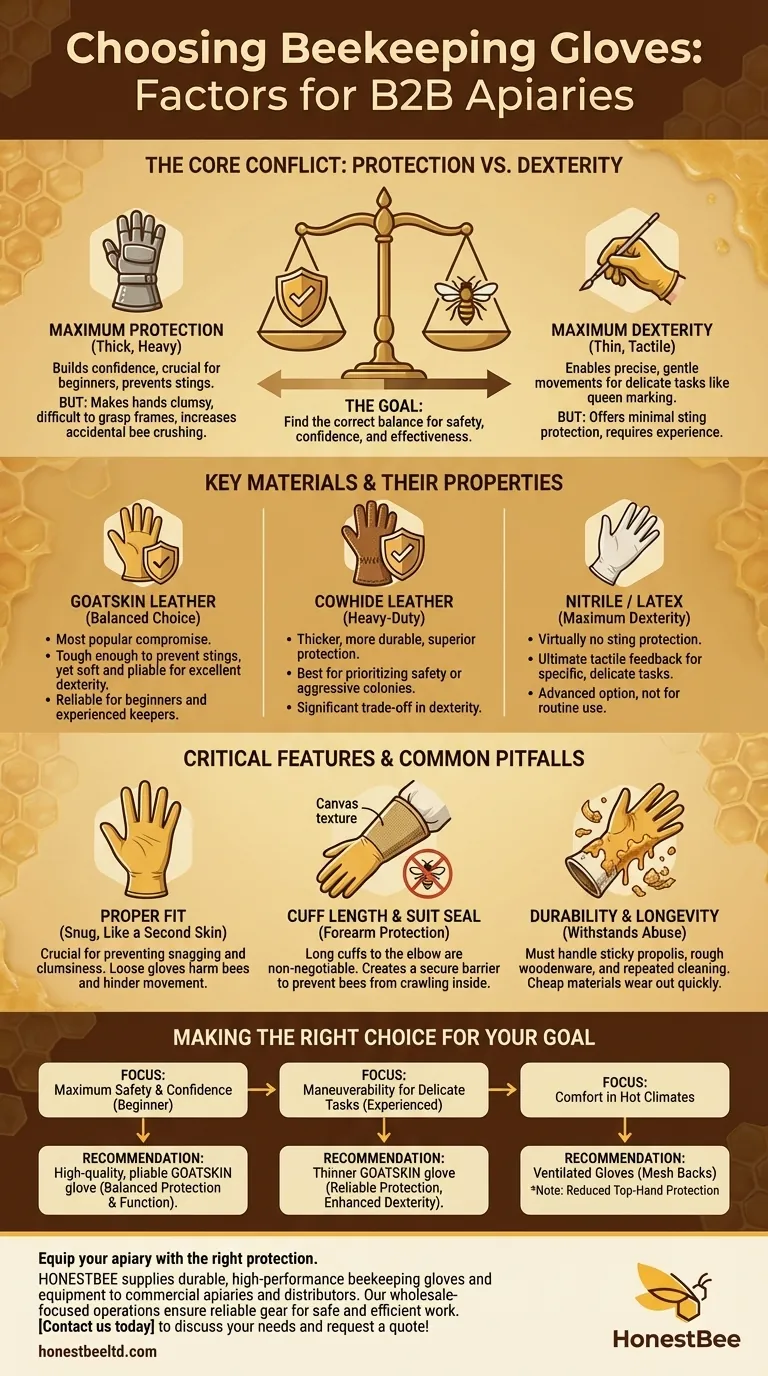Choosing the right beekeeping gloves is determined by four primary factors: the material's protective qualities, the level of dexterity they allow, their overall fit, and the length of the cuff. These elements work together to define your safety, confidence, and effectiveness when handling your bees.
The central challenge in selecting beekeeping gloves is not simply finding the most protective pair, but striking the correct balance between protection from stings and the dexterity required to work carefully and gently.
The Core Conflict: Protection vs. Dexterity
Your ability to work calmly and effectively inside a hive depends entirely on navigating the trade-off between feeling safe and being able to manipulate equipment properly.
Why Maximum Protection Isn't Always Best
Thick, heavy gloves provide the most sting protection, which is crucial for building confidence as a new beekeeper.
However, this thickness can make your hands clumsy. Bulky gloves make it difficult to grasp frames, handle tools, or avoid accidentally crushing bees—actions that can agitate a colony.
The Importance of Tactile Feedback
Dexterity, or the ability to feel what you are doing, allows for more precise and gentle movements.
Gloves that offer better tactile feedback help you perform delicate tasks, like marking a queen or inspecting brood, with greater care and less disruption to the hive.
Key Glove Materials and Their Properties
The material of your glove is the single biggest factor influencing the balance between protection and dexterity.
Goatskin Leather: The Balanced Choice
Goatskin is the most popular material for beekeeping gloves because it offers a very effective compromise.
It is tough enough to prevent most stings yet remains soft and pliable, providing excellent dexterity. This makes it a reliable choice for both beginners and experienced keepers.
Cowhide Leather: The Heavy-Duty Option
Cowhide is thicker and more durable than goatskin, offering superior sting protection.
This added thickness comes at the cost of dexterity and can make fine movements difficult. It is best suited for beekeepers who prioritize protection above all else or for tasks like removing aggressive colonies.
Nitrile/Latex: For Maximum Dexterity
Some experienced beekeepers prefer using disposable nitrile or latex gloves for specific tasks.
These offer virtually no sting protection but provide the ultimate dexterity for delicate work. This is an advanced option and not recommended for routine inspections.
Critical Features and Common Pitfalls
Beyond the primary material, a few key design features determine a glove's true effectiveness.
The Critical Role of a Proper Fit
Your gloves must fit snugly, like a second skin, but not be so tight that they restrict circulation.
Loose-fitting gloves have excess material at the fingertips that can snag on hive parts and accidentally harm bees. A poor fit is a primary cause of clumsiness.
Cuff Length and the Suit Seal
Effective beekeeping gloves feature long cuffs, typically made of canvas, that extend to the elbow.
This forearm protection is non-negotiable. It is critical that the cuff creates a secure overlap with your beesuit or jacket sleeve to prevent bees from crawling inside.
Durability and Longevity
Beekeeping involves sticky propolis and rough woodenware. Your gloves must be made of a durable material that can withstand repeated use and cleaning.
Thin, cheap gloves, like cotton garden gloves, offer insufficient protection and will wear out quickly, making them a poor and unsafe investment.
Making the Right Choice for Your Goal
Select your gloves based on your experience level and primary objective in the apiary.
- If your primary focus is maximum safety and confidence (Beginner): Choose a high-quality, pliable goatskin glove that offers a great balance of protection and function.
- If your primary focus is maneuverability for delicate tasks (Experienced): A thinner goatskin glove provides the dexterity you need while still offering reliable protection.
- If your primary focus is comfort in hot climates: Consider ventilated gloves with mesh backs, but be aware that they may offer less protection on the top of your hands.
The right pair of gloves will make you a more confident, gentle, and competent beekeeper.
Summary Table:
| Factor | Key Consideration | Impact on Beekeeping |
|---|---|---|
| Material | Goatskin (balanced), Cowhide (heavy-duty), Nitrile (max dexterity) | Defines the core protection vs. dexterity trade-off. |
| Dexterity | Tactile feedback for delicate tasks like handling frames or marking queens. | Enables gentle, precise work to avoid agitating the colony. |
| Fit | Snug, like a second skin, without restricting movement. | Prevents snagging and clumsiness; loose gloves can harm bees. |
| Cuff Length | Long cuff that securely overlaps with the beesuit sleeve. | Essential for forearm protection; prevents bees from crawling inside. |
Equip your apiary with the right protection. HONESTBEE supplies durable, high-performance beekeeping gloves and equipment to commercial apiaries and distributors. Our wholesale-focused operations ensure you get the reliable gear you need to work safely and efficiently. Contact us today to discuss your needs and request a quote!
Visual Guide

Related Products
- Mesh Ventilated 3 Layer Goatskin Beekeepers Gloves for Beekeeping
- Goatskin Leather Beekeeper Gloves with Vent Long Sleeve for Beekeeping Honey Bee Sting Proof Protection
- Goat Skin Leather Bee Sting Proof Beekeeping Gloves with Canvas Sleeve
- Professional Drop-Style Hive Handles for Beekeeping
- HONESTBEE Professional Long Handled Hive Tool with Precision Cutting Blade
People Also Ask
- Do beekeeping gloves completely prevent stings? Maximize Your Hive Safety and Confidence
- Why is it important to have gloves available even if not always worn? Essential Risk Management for Beekeepers
- What is the role of gloves in beekeeping, especially for beginners? Build Confidence & Safety
- How do beekeeping gloves increase comfort during long sessions? Enhance Focus and Reduce Fatigue
- What factors should be considered when selecting beekeeping gloves? Balance Protection and Dexterity



















